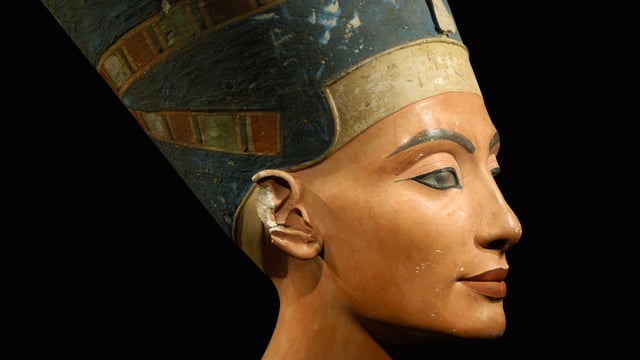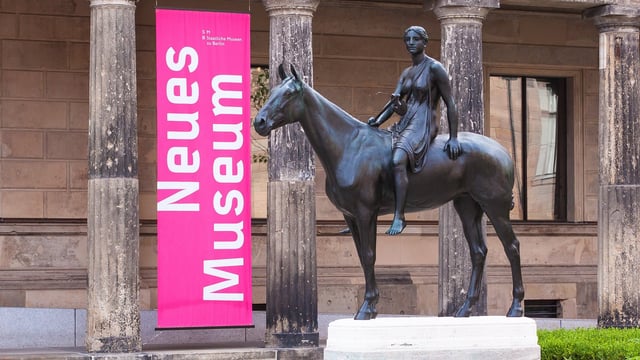On 6 December 1912 a limestone bust of Nefertiti was unearthed by a German archaeological team led by Ludwig Borchardt. The archaeologists were excavating in Armana, and came upon the ancient sculptor Thutmose’s workshop. Frequently described as the most famous face from antiquity, this bust of Nefertiti is perhaps rivalled only by Tutankhamun’s death mask. Just over two decades later another bust of Nefertiti was uncovered at Amarna. Known as the ‘Unfinished Head of Neferititi’ this artefact is now in the Egyptian Museum in Cairo.
- Thomas Dowson
- Last Checked and/or Updated 5 April 2023
- No Comments
- Amazing Artefacts, Berlin
Although there are no identifying inscriptions on the bust, the characteristic crown is one that is worn by Nefertiti in other identifiable representations of her. As iconic as this representation of an ancient Egyptian woman has come to be, for feminine beauty and culture in Berlin, it has not been without controversy.
The lack of any specific identification and that the bust did not appear in public until 1924 (an 11 year period from the date of its discovery for which there no records of the bust) has lead some to suggest that the bust is a modern forgery. Henri Stierlin, a Swiss art historian, and a few others think so (Is this Nefertiti – or a 100-year-old fake?).
But few specialists and Egyptologists who have worked extensively with the bust give much credence to these views. A detailed account Re-Examining Nefertiti’s Likeness and Life, by Matthias Schulz can be read on Spiegel Online.
More recent research using CT Scans shows that the sculpture has a limestone core rendered by a gypsum stucco layer. The scan revealed that the inner face was carved showing bags under the eyes, creases around the mouth and cheeks and a swelling on the nose. The painted stucco layer eradicates these natural signs of ageing producing a more perfect image.

Where Was the Bust of Nefertiti Found?
The bust was found in what was the workshop of Thutmose, in the ancient city of Amarna, Egypt. Amarna is a vast archaeological site – the ruins of the capital city that was established by the Pharaoh Akhenaten in the late Eighteenth Dynasty. Ludwig Borchardt’s team excavated the bust in 1912. Ten years after the Nefertiti bust went on display in Berlin, another bust of Nefertiti was uncovered at Amarna during excavations led by John Devitt Stringfellow Pendlebury and James Hilary Sheffield Waddington, and funded by the Egypt Exploration Society.
Although the 1933 bust is unfinished, the similarities between the two busts are quite remarkable. Made from quartzite, the bust was also found in a sculptors workshop, along with other pieces that would have been used to make up a composite statue. The notched area at the top of the head would have been fitted with a head piece, either a wig or a crown. And the head attached to a composite statue. Further evidence that the bust was unfinished can be seen on the face, where the black artist’s guidelines are still visible. Read more about the unfinished bust in an article written by Courtney Marx of the American Research Center in Egypt. See also Danderson4’s 3d model of the unfinished buts of Nefertiti.

Where is the Bust of Nefertiti Today?
Despite repeated requests for the repatriation of the bust since its 1924 public unveiling in Berlin (Did Germany Cheat to Get Bust of Nefertiti? Spiegel International), Nefertiti’s bust is still on display in the German capital. Thutmose’s bust of Nefertiti is part of the the Egyptian Museum and Papyrus Collection, which along other prehistoric and classical collections, is housed in the newly restored Neues Museum.
For more much more detailed information about the Nefertiti Bust in Berlin, read the extensive documentation on the Egyptian Museum and Papyrus Collection website. Here you can read a detailed and authoritative account of Queen Nefertiti, the finding of the bust, what makes it such a significant artefact, how it came to be in Germany, as well as the reception of the bust in contemporary culture.

Is Thutmose’s Bust of Nefertiti on Public Display?
Yes, the bust is on display in the Neues Museum on Museumsinsel in Berlin. In fact, seeing Nefertiti’s bust is high on many people’s list of things to do in Berlin, not just history geeks. Today, Nefertiti is in a small glass case in a small circular gallery, and she enjoys tight security. Photography is not permitted, and there are signs everywhere.
For more information about buying tickets for the Neues Museum, and other museums on Museuminsel – either individually or as a combination ticket, day passes and skip-the-line-ticket, see your options in our Guide to Buying Tickets for Museumsinsel & Museums in Berlin.
History With Kids
So significant is the 1912 arrival of Nefertiti’s bust in Berlin, this event has been included in the city’s ‘miniature history’ at Little Big City Berlin. Understandably a great attraction with an accessible story of Berlin for children, but also an enjoyable experience for adults too.

Add Neues Museum to Your Itineraries & Travel Lists
Neues Museum, Museumsinsel
The ‘New Museum’ was completed in 1855, but suffered considerable damage during World War II. After a major refurbishment it re-opened in 2009. The museum houses three collections: the Egyptian Museum and Papyrus Collection, the Museum for Prehistory and Early History, and the Collection of Classical Antiquities. One of the most celebrated pieces is the bust of Nefertiti.





